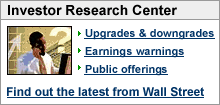Nasdaq hits new 6-year highTech-heavy composite marks best close since 2001, S&P 500 ekes out second straight record, Dow dips.NEW YORK (CNNMoney.com) -- Tech stocks rose Thursday, pushing the Nasdaq composite to its highest close in more than six years, thanks to the latest wave of corporate deals. The S&P 500 barely eked out a fresh all-time high in a tough session for the blue chips. The Dow Jones industrial average (up 0.00 to 13,633.08, Charts) lost a few points, according to early tallies. The blue-chip barometer briefly touched a new intraday record of 13,672.82 in the morning after ending the previous session at a fresh closing high. The broader S&P 500 index (up 1.11 to 1,531.34, Charts) added less than half a point, managing to end at a new all-time high. The broad index hit a record close Wednesday, eclipsing the old record from March 2000, at the top of the bull market sparked by the late 1990s tech rally. The Nasdaq composite (up 11.70 to 2,604.29, Charts) gained 0.5 percent, ending at a 6-year high. Treasury prices slipped, the dollar gained versus other major currencies and oil and gold rose. Here's a look at what was moving near the close. All three major gauges rose in the morning, as investors welcomed the latest deals and a drop in oil prices. But the blue-chip averages struggled to maintain gains, as the session wore on, and oil prices rebounded. Additionally, investors were sorting through the session's economic news. Reports on manufacturing, construction and jobless claims showed improvement. But first-quarter economic growth came in weaker than first thought, at the slowest pace since 2002. With the Dow, S&P 500 and Russell 2000 at all-time highs, concerns have again been raised about whether stocks are in for a bigger retreat, particular with the economic outlook still uncertain. While such a pullback is a possibility, there are enough supportive factors at work that stocks should be able to keep moving higher for now, said Douglas Roberts, managing principal at Channel Capital Research. Roberts said that gains will continue to be sustained by the tremendous flow of money into the stock market, both from he United States and from investors abroad, through takeovers, mergers and corporate stock buybacks. In the next few months, the bigger risk may be from the calendar, when light summer trading can lead to bigger day-to-day swings in the market. GDP grew at just a 0.6 percent annual rate in the first quarter, the government said Thursday morning, down from its initial read of 1.3 percent. Analysts expected growth of 0.8 percent. But other reports released in the morning were more upbeat. The Chicago PMI, a measure of manufacturing in the Midwest region, rose to 61.7 in May from 52.9 in April. Economists surveyed by Reuters thought it would rise to 54.0, on average. Construction spending rose 0.1 percent in April, versus forecasts for an unchanged reading, after rising 0.6 percent the previous month. And the number of Americans filing new claims for unemployment last week fell more than expected. Taken as a whole, the reports seemed to suggest that the economy is chugging along, but not so fast or so slow as to raise concerns. "I guess a good way to sum it up is we're seeing growth, slow growth, but growth nonetheless," said Channel Capital's Roberts. In terms of the Federal Reserve, the reports suggest the central bank's going to stay "steady as she goes," Roberts said, noting the Fed is still unlikely to cut or raise interest rates anytime soon. Stocks rallied Wednesday, with the Dow and S&P 500 ending at all-time highs as investors focused on the positive parts of the minutes from the last Fed policy meeting, including the banker's observation that risks to the economy have lessened. The minutes helped cool some worries sparked by a selloff in global markets, following a pummeling in Chinese stocks after the government tripled the tax on share trades in a bid to slow the surging stock market. Thursday brought its share of M&A and other corporate news. Wachovia (down $0.33 to $54.22, Charts, Fortune 500) is buying A.G. Edwards (up $11.03 to $88.18, Charts) for $6.8 billion in cash and stock in a move that will create the second-largest U.S. retail brokerage. Wachovia shares slipped while A.G. Edwards shares jumped 13 percent. Morgan Stanley (down $0.72 to $85.10, Charts, Fortune 500)'s real estate unit is buying Australia's Investa Property Group for $3.9 billion in cash. Morgan Stanley shares were barely changed. Ceridian (up $1.09 to $35.28, Charts), a payroll processor, agreed to be bought out by private equity firm Thomas H. Lee Partners and insurance firm Fidelity National Insurance for $5.3 billion in cash. Ceridian gained 3 percent. In other news, Dendreon (up $1.84 to $8.58, Charts) rallied 33 percent in active Nasdaq trade on bets that its prostrate cancer treatment Provenge is closer to getting approval. The biotech said that the Food and Drug Administration could grant Provenge approval next year if its current trial shows positive results. Ciena (up $5.07 to $34.35, Charts) jumped 14 percent after the telecom gear maker reported higher-than-expected quarterly results and boosted its 2007 revenue growth forecast. Market breadth was positive. On the New York Stock Exchange, winners beat losers 6 to 5 on volume of 1.33 billion shares. On the Nasdaq, advancers topped decliners by 8 to 7 on volume of 1.92 billion shares. U.S. light crude oil for July delivery rose 52 cents to $64.01 a barrel on the New York Mercantile Exchange. Prices were volatile following the weekly oil inventories report, which showed a surprise drop in crude oil supplies. Treasury prices slipped, raising the yield on the 10-year note to 4.90 percent from 4.87 percent late Wednesday. Bond prices and yields move in opposite directions. In currency trading, the dollar gained modestly versus the euro and the yen. |
|


